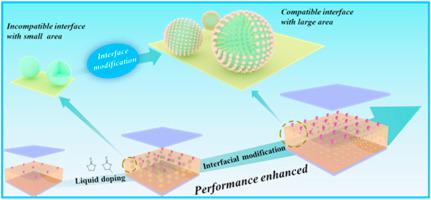Nano Energy ( IF 16.8 ) Pub Date : 2020-09-18 , DOI: 10.1016/j.nanoen.2020.105374 Titao Jing , Bingang Xu , Yujue Yang , Chenghanzhi Jiang , Mengjie Wu

|
Composites' interface is the contact area between filler and matrix, which is a critical issue in composites' permittivity and thereby of great value to improve friction composites' performance in triboelectric nanogenerators (TENGs). However, composites' interfacial influence on triboelectric performance was not clear in past years even numerous composites were prepared, which limited materials' advance of triboelectric performance. Here, a systematic investigation about the composites' interfacial influence was performed on liquid doping polydimethylsiloxane (PDMS) composites, in which interfacial area and compatibility were found with great importance to composites' permittivity and triboelectric performance. Through high preparation stirring speed and appropriate surfactant additive, interfacial modification of enlarging interfacial area and compatible interface was facilely achieved. The as-prepared composites' permittivity and triboelectric performance were remarkably promoted as compared to composites without interfacial modification, achieving 8.1-fold in output voltage and 9.5-fold in output current of pristine PDMS. Further, the composites were applied to assemble TENG for energy harvesting and movement detection. This work revealed the interface properties’ influence on composites permittivity and further demonstrated the importance of interfacial modification for enhancement of triboelectric performance, illustrating that the interface issues should be taken into consideration in doping triboelectric composites for high output performance TENG.
中文翻译:

界面改性提高了高性能柔性摩擦电纳米发电机液体掺杂复合材料的介电常数和摩擦电性能
复合材料的界面是填料和基体之间的接触区域,这是复合材料介电常数的关键问题,因此对于提高摩擦复合材料在摩擦电纳米发电机(TENGs)中的性能具有重要价值。然而,近年来,即使制备了许多复合材料,复合材料对摩擦电性能的界面影响仍不清楚,这限制了材料的摩擦电性能。在此,对液体掺杂的聚二甲基硅氧烷(PDMS)复合材料的界面影响进行了系统的研究,发现界面面积和相容性对复合材料的介电常数和摩擦电性能非常重要。通过高准备搅拌速度和适当的表面活性剂添加剂,轻松实现了扩大界面面积和兼容界面的界面修饰。与未进行界面改性的复合材料相比,所制备的复合材料的介电常数和摩擦电性能得到了显着提高,输出电压达到原始PDMS的8.1倍,输出电流达到9.5倍。此外,将复合材料应用于组装TENG,以进行能量收集和运动检测。这项工作揭示了界面性能对复合材料介电常数的影响,并进一步证明了界面改性对于增强摩擦电性能的重要性,说明在为高输出性能TENG掺杂摩擦电复合材料时应考虑界面问题。与未进行界面改性的复合材料相比,所制备的复合材料的介电常数和摩擦电性能得到了显着提高,输出电压达到原始PDMS的8.1倍,输出电流达到9.5倍。此外,将复合材料应用于组装TENG,以进行能量收集和运动检测。这项工作揭示了界面性能对复合材料介电常数的影响,并进一步证明了界面改性对于增强摩擦电性能的重要性,说明在为高输出性能TENG掺杂摩擦电复合材料时应考虑界面问题。与未进行界面改性的复合材料相比,所制备的复合材料的介电常数和摩擦电性能得到了显着提高,输出电压达到原始PDMS的8.1倍,输出电流达到9.5倍。此外,将复合材料应用于组装TENG,以进行能量收集和运动检测。这项工作揭示了界面性能对复合材料介电常数的影响,并进一步证明了界面改性对于增强摩擦电性能的重要性,说明在为高输出性能TENG掺杂摩擦电复合材料时应考虑界面问题。原始PDMS的输出电压为1倍,输出电流为9.5倍。此外,将复合材料应用于组装TENG,以进行能量收集和运动检测。这项工作揭示了界面性能对复合材料介电常数的影响,并进一步证明了界面改性对于增强摩擦电性能的重要性,说明在为高输出性能TENG掺杂摩擦电复合材料时应考虑界面问题。原始PDMS的输出电压为1倍,输出电流为9.5倍。此外,将复合材料应用于组装TENG,以进行能量收集和运动检测。这项工作揭示了界面性能对复合材料介电常数的影响,并进一步证明了界面改性对于增强摩擦电性能的重要性,说明在为高输出性能TENG掺杂摩擦电复合材料时应考虑界面问题。











































 京公网安备 11010802027423号
京公网安备 11010802027423号